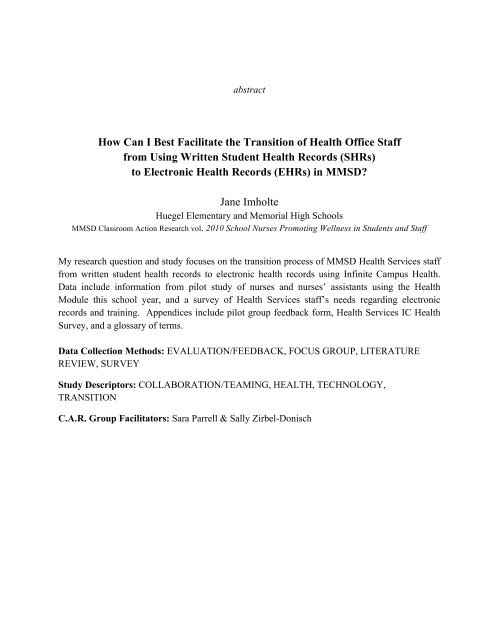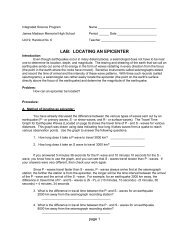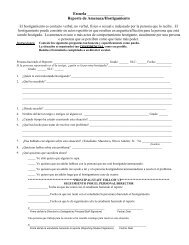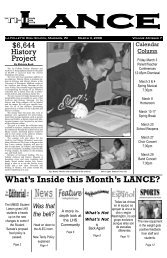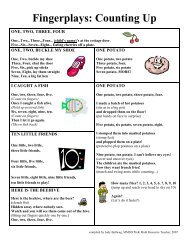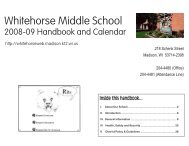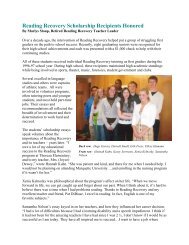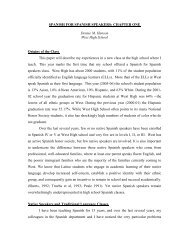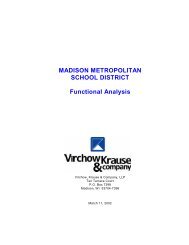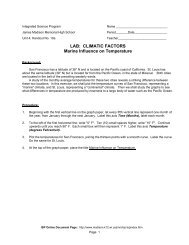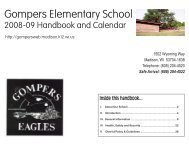How Can I Best Facilitate the Transition of Health Office Staff from ...
How Can I Best Facilitate the Transition of Health Office Staff from ...
How Can I Best Facilitate the Transition of Health Office Staff from ...
Create successful ePaper yourself
Turn your PDF publications into a flip-book with our unique Google optimized e-Paper software.
abstract<strong>How</strong> <strong>Can</strong> I <strong>Best</strong> <strong>Facilitate</strong> <strong>the</strong> <strong>Transition</strong> <strong>of</strong> <strong>Health</strong> <strong>Office</strong> <strong>Staff</strong><strong>from</strong> Using Written Student <strong>Health</strong> Records (SHRs)to Electronic <strong>Health</strong> Records (EHRs) in MMSD?Jane ImholteHuegel Elementary and Memorial High SchoolsMMSD Classroom Action Research vol. 2010 School Nurses Promoting Wellness in Students and <strong>Staff</strong>My research question and study focuses on <strong>the</strong> transition process <strong>of</strong> MMSD <strong>Health</strong> Services staff<strong>from</strong> written student health records to electronic health records using Infinite Campus <strong>Health</strong>.Data include information <strong>from</strong> pilot study <strong>of</strong> nurses and nurses’ assistants using <strong>the</strong> <strong>Health</strong>Module this school year, and a survey <strong>of</strong> <strong>Health</strong> Services staff’s needs regarding electronicrecords and training. Appendices include pilot group feedback form, <strong>Health</strong> Services IC <strong>Health</strong>Survey, and a glossary <strong>of</strong> terms.Data Collection Methods: EVALUATION/FEEDBACK, FOCUS GROUP, LITERATUREREVIEW, SURVEYStudy Descriptors: COLLABORATION/TEAMING, HEALTH, TECHNOLOGY,TRANSITIONC.A.R. Group Facilitators: Sara Parrell & Sally Zirbel-Donisch
HOW CAN I BEST FACILITATE THE TRANSITION OF HEALTH OFFICE STAFFFROM USING WRITTEN STUDENT HEALTH RECORDS (SHRs)TO ELECTRONIC HEALTH RECORDS (EHRs) IN MMSDBackgroundJane ImholteHuegel Elementary and Memorial High SchoolI have been a school nurse in Madison for twenty years completing my first ClassroomAction Research in 2008 on elementary students needing to sleep during <strong>the</strong> school day. I haveworked primarily in <strong>the</strong> elementary and early childhood setting as a school nurse until four yearsago when <strong>the</strong> opportunity presented for me to practice at <strong>the</strong> high school level. I have had <strong>the</strong>opportunity to work at West High School and currently at Memorial High School. Since so much<strong>of</strong> my previous school nurse practice has been with younger children, I felt <strong>the</strong> need to look moreintensively at my high school practice.So, to try to increase my knowledge and improve my practice with high school students Iam again doing Classroom Action Research (CAR). At both <strong>of</strong> <strong>the</strong> high schools, I have had <strong>the</strong>good fortune to work in collaboration with two o<strong>the</strong>r school nurses. I value this collaboration asmy previous school nurse practice has been an isolated role being <strong>the</strong> “only school nurse” in <strong>the</strong>school. It is truly wonderful to work toge<strong>the</strong>r as a team.Developing a QuestionThere are many questions and topic areas to explore and learn more about for me at <strong>the</strong>high school level. My nurse colleague and I decided to work toge<strong>the</strong>r on CAR with <strong>the</strong> hope thatwe could learn toge<strong>the</strong>r and be able to make a difference for our students. We identified severalcommon problems as high school nurses. Initially, we questioned high school students’perceptions <strong>of</strong> health, wellness and prevention because we see so many students seeking healthcare on a “need to” basis by going to <strong>the</strong> Emergency Room, and many students don’t have aprimary care provider/clinic. Fur<strong>the</strong>r, when we arrange for students to go for physicals, withtransportation arranged outside <strong>of</strong> school hours, <strong>the</strong>y frequently do not keep <strong>the</strong>se appointments.We wondered what we could do to motivate high school students to seek primary, preventativehealth care.
<strong>How</strong>ever, after my colleague met with a student regarding a negative pregnancy test, wehad questions regarding our role with students on this issue. The student was disappointed shewasn’t pregnant because she had relationship problems with her mo<strong>the</strong>r and she thought a baby“would love her unconditionally”. In addition, <strong>the</strong> student shared that she has friends with babieswho say “it is easy.” We both were surprised by this interaction and it caused more discussion,reading, and thinking on our part and we considered a question: how can I as a school nurse helpadolescents with low self – esteem <strong>from</strong> participating in high risk behaviors? In our practice atMemorial, we observed that more African-American adolescent females were getting pregnantand keeping <strong>the</strong>ir babies. We wondered about <strong>the</strong>ir process for considering options, and believed<strong>the</strong>y were limiting <strong>the</strong>ir expectations. In some cases, it appeared as if becoming a mo<strong>the</strong>r wasvalued higher than completing <strong>the</strong>ir high school education. Or perhaps <strong>the</strong>y thought <strong>the</strong>y coulddo both. Our question evolved, again: how can we increase our understanding <strong>of</strong> <strong>the</strong> factorsinfluencing African-American adolescent females regarding sexual activity and pregnancy? Tobegin, we decided to interview three to four high school aged African- American students who arecurrently pregnant and/or are parenting and attending high school. <strong>How</strong>ever, I became concernedabout talking to adolescents about sensitive subject areas (sexual activity, contraception andpregnancy, to name a few) without parent permission, and needed to explore <strong>the</strong> consent issuefur<strong>the</strong>r.Onward, right? Wrong! A change in direction occurred when my colleague decided towithdraw <strong>from</strong> CAR. Flexibility is <strong>the</strong> name <strong>of</strong> <strong>the</strong> game for school nurses, and I elected tochoose a topic more related to a different part <strong>of</strong> my role. Two years ago my assignment changedto include working as one <strong>of</strong> two nurse team-leaders charged with implementing Infinite Campus<strong>Health</strong> (our MMSD information s<strong>of</strong>tware system) and <strong>the</strong> change over to electronic health records(EHRs) in MMSD <strong>Health</strong> Services.Some assumptions I have regarding using EHRs are that health care providers (HCPs)would increase <strong>the</strong>ir efficiency and, <strong>the</strong>refore, increase time spent providing care and improvinghealth care quality. I have always taken pride in my nursing practice as being a very thoroughpractitioner which includes completing careful documentation <strong>of</strong> <strong>the</strong> care I provide. This beingsaid, I feel school nurses have to duplicate and over document in our district which takes us away<strong>from</strong> caring for students. We document in <strong>the</strong> Omega system. We chart medications on <strong>the</strong>
medication log. We also chart medication that we are giving in <strong>the</strong> cumulative medication log in<strong>the</strong> SHR. Then, we also chart updates on student health conditions and some health <strong>of</strong>fice visitsin <strong>the</strong> SHR. As school budgets become tighter, allocations for school nurses and nurse’sassistants will most likely also be reduced; we are challenged to be as efficient as possible andstill provide <strong>the</strong> best quality care that we can. It is my assumption that that EHRs may decrease<strong>the</strong> “paperwork” part <strong>of</strong> our jobs and allow more time to give more care to students. Finally, I amconcerned that transitioning school health <strong>of</strong>fice staff to <strong>the</strong> use <strong>of</strong> EHRs will be difficult withresistance to changing <strong>from</strong> written to electronic record-keeping. My research question became:<strong>How</strong> can I best facilitate <strong>the</strong> transition <strong>of</strong> health <strong>of</strong>fice staff <strong>from</strong> using written studen<strong>the</strong>alth records (SHRs) to electronic health records (EHRs) in MMSD? (See Glossary orTerms for definitions <strong>of</strong> all technical terms.)Literature ReviewIn <strong>the</strong> state <strong>of</strong> Wisconsin, <strong>the</strong>re are several types <strong>of</strong> student records. It is important tounderstand <strong>the</strong> different types <strong>of</strong> student records as <strong>the</strong>y each have different confidentiality,sharing and retention rules. Pupil physical health records means “ those pupil records thatinclude basic health information about a pupil, including <strong>the</strong> pupil’s immunization records, anemergency medical card, a log <strong>of</strong> first aid and medicine administered to <strong>the</strong> pupil, an athleticpermit card, a record concerning <strong>the</strong> pupil’s ability to participate in an education program, anylead screening records required under statue no. 254.162, <strong>the</strong> results <strong>of</strong> any routine screeningtest, such as for hearing, vision or scoliosis, and any follow up to such test, and any o<strong>the</strong>r basichealth information, as determined by <strong>the</strong> state superintendent.” (Wisconsin State Legislature)The student health record (SHR) is a “patient health care record (PHR) “ any pupil record thatrelates to a pupil’s physical health (excluding HIV testing records) and that is not a pupilphysical health record shall be treated as a patient health care record under statute nos. 146.81to 146.84” . (Wisconsin State Legislature)According to Schwab and Pholman (2004), school nurses have questions regarding <strong>the</strong>ownership and storage location <strong>of</strong> student health records (SHRs). The school nurse functions as ahealth care pr<strong>of</strong>essional and a student support person in schools. The school nurse isknowledgeable about what information <strong>from</strong> <strong>the</strong> student’s health record can and cannot be shared
with school staff which is most <strong>of</strong>ten based on school district policies and procedures andindividual state laws and confidentiality statutes.The first national survey on RN use <strong>of</strong> EHRs was completed by DesRoches et al, (2008)looking at <strong>the</strong> relationship <strong>of</strong> registered nurses’ (RNs) use <strong>of</strong> EHR, beliefs about <strong>the</strong> quality <strong>of</strong>care and if use <strong>of</strong> EHRs is associated with less time spent doing paperwork and more timeproviding direct care to patients. The findings <strong>of</strong> this study were that <strong>the</strong> routine use <strong>of</strong> minimallyfunctional EMRs by RNs in inpatient and ambulatory settings varied and that less than 1 in 5 RNswork currently in settings that endorsed minimally functional EHRs. There were generalconcerns that using EHRs would increase time spent completing documentation. <strong>How</strong>ever, <strong>the</strong>study revealed that RNs do not spend more time completing patient documentation when usingEHRs.A study by O. G. Otieno et al. (2007) noted that even though EHRs are being used inmany healthcare settings, and that <strong>the</strong>ir effective and efficient data processing benefits healthcareproviders, little evaluation has been completed by <strong>the</strong>ir users. The aim <strong>of</strong> this study was todevelop a survey instrument to measure nurses’ EHR use, quality and satisfaction. The researchoutcomes include a proposed, generalized, standardized instrument to measure EHR use, qualityand user satisfaction.The use <strong>of</strong> EHRs was examined in a recent study by P. Carayon et al. (2009) about howEHRs can be used to improve clinician performance and produce positive individual andorganizational outcomes. This study described a case study <strong>of</strong> <strong>the</strong> implementation <strong>of</strong> a EHRssystem in a small family practice clinic. The data showed increased computer entry by physiciansbut few changes in <strong>the</strong>ir work practices. <strong>How</strong>ever, <strong>the</strong>re were major changes in <strong>the</strong> work <strong>of</strong> o<strong>the</strong>rclinic and <strong>of</strong>fice staff.Ga<strong>the</strong>ring DataMMSD explored several student information s<strong>of</strong>tware systems to purchase for district useincluding Infinite Campus. O<strong>the</strong>rs that were considered and rejected include; Century StarStudent, eSis, paC Skyward, Power School and Zangle C Innovation. <strong>Health</strong> ServicesCoordinator, Freddi Adelson, was involved in <strong>the</strong> student information s<strong>of</strong>tware review processalong with a committee <strong>of</strong> o<strong>the</strong>r MMSD administrators and staff members.
My IC <strong>Health</strong> journey began in fall 2008 along with ano<strong>the</strong>r school nurse, Colleen Duffie.We are allocated one half day each week to work on IC <strong>Health</strong> with <strong>the</strong> goal being to see if IC<strong>Health</strong> could be used in MMSD <strong>Health</strong> Services. This doesn’t sound like such a big deal initiallybut it is much more complicated <strong>the</strong>n it would seem. First <strong>of</strong> all, we are nurses and not computerexperts or programmers. <strong>How</strong>ever, we have experience and knowledge about school nursing andworking in school health <strong>of</strong>fices with students, parents and staff. We initially weren’t even ableto find <strong>the</strong> <strong>Health</strong> module in <strong>the</strong> IC Sandbox. Slowly, with <strong>the</strong> help and patience <strong>of</strong> <strong>the</strong> MMSDIC computer technician, we were able to develop and pilot <strong>the</strong> screening tab and hearing andvision follow up tab to complete a pilot in several schools by <strong>the</strong> end <strong>of</strong> <strong>the</strong> first year we workedon IC <strong>Health</strong>. Then, we went district wide in fall <strong>of</strong> 2009, asking all <strong>Health</strong> <strong>Office</strong> staff to record<strong>the</strong> results <strong>of</strong> hearing and vision screening in IC <strong>Health</strong>.In December 2009, health <strong>of</strong>fice staff was asked for feedback on <strong>the</strong> use <strong>of</strong> IC <strong>Health</strong> (seeAppendix I). This survey included questions about using IC for vision and hearing screening, <strong>the</strong>use <strong>of</strong> <strong>Health</strong> Conditions tab, <strong>the</strong> <strong>Health</strong> Alerts program, Contact Log and current IC <strong>Health</strong>directions. Eight responses were received. Some health <strong>of</strong>fice staff used IC for entering Hearingand Vision screening results and some had used <strong>the</strong> screening follow up tab. Most didn’t knowwhere to find <strong>the</strong> chart <strong>of</strong> Vision Follow up Codes and <strong>the</strong> LEA Vision Screening ConversionChart. Most respondents used <strong>the</strong> Contact Log every time <strong>the</strong>y speak with a parent and find ittime saving because <strong>of</strong> not having to document in two places (Contact Log and SHRs). They didhave some problems using IC for creating and formatting class lists.Next, health <strong>of</strong>fice staffs <strong>from</strong> five MMSD schools were trained to pilot IC <strong>Health</strong> <strong>Office</strong>Visits, <strong>Health</strong> <strong>Office</strong> Calendar, Medications and Treatments to begin on <strong>the</strong> first day <strong>of</strong> <strong>the</strong> 2009-10 school year, replacing <strong>the</strong> Omega system. The following problem areas were identified <strong>from</strong>this pilot group during <strong>the</strong> 2009-10 school year:• Missing data issues• Making changes to text in IC: Inability to track who makes changes or when changes are made.• Where to input free text and notes?
<strong>Health</strong> <strong>Office</strong> Visits comment box or Complaint box Contact Log Conditions updates Need a place to be able to put “non-visit” information for that would typically gointo <strong>the</strong> SHR.• Medications/Treatments History <strong>of</strong> previous medications/treatments ordered or given Unable to submit additional medication supply without entering entire medicationas if new order Dose submitted issues Medication amount shows a negative number under “remaining doses” When medication is “below threshold” student no longer will show up on<strong>Health</strong> <strong>Office</strong> Daily Calendar unless re-entered as a new medication “As needed” medications don’t show up as a choice under “add med dose”if <strong>the</strong>re are 0 doses remaining, will have to re-enter as if a new medication• Overall slowness <strong>of</strong> <strong>the</strong> system especially for students with daily scheduled healthvisits was a concern especially when several students present at <strong>the</strong> same time andneed to be given care.The last data collected was The Infinite Campus <strong>Health</strong> Services Survey (see Appendix II)completed by school nurses and nurse’s assistants to seek information regarding <strong>the</strong>ir current IC<strong>Health</strong> comfort level. This survey also asked what aspects <strong>of</strong> <strong>the</strong> current Omega System HO stafffind most useful to determine if similar functionality will be needed in IC <strong>Health</strong>. Finally, thissurvey sought input <strong>from</strong> health <strong>of</strong>fice staff about <strong>the</strong>ir training needs in <strong>the</strong> transition <strong>from</strong>written SHRs to EHRs. There were a total <strong>of</strong> 61 surveys completed; 29 by school nurses and 32by nurse’s assistants. The data collected <strong>from</strong> <strong>the</strong>se surveys are included in <strong>the</strong> following charts:
Nurses and nurse’s assistants are very comfortable using student information, <strong>the</strong> contactlog and completing Hearing and Vision screening in IC <strong>Health</strong>. Nurses are verycomfortable using <strong>Health</strong> Alerts and <strong>Health</strong> Conditions in IC <strong>Health</strong>. Both are generallynot comfortable creating and using Ad Hoc Queries and Excel.
The parts <strong>of</strong> <strong>the</strong> current Omega System that Nurses and Nurse’s Assistants find mos<strong>the</strong>lpful are <strong>the</strong> daily log with scheduled medications and procedures, current school yearstudent HO visit history and to a lesser degree, student HO visit history transferring to new
school when students transfer to different MMSD schools. The capability to printmedication and procedure lists was not found to be helpful because <strong>the</strong>se lists change s<strong>of</strong>requently so staff use <strong>the</strong> HO computerized log and also refer to <strong>the</strong> written logs completedby school nurses that are kept in <strong>the</strong> medication binder in <strong>the</strong> HO.
Question #3 responses show generally that nurses and nurse’s assistants feel that havingmore menu choices, more service provision choices, <strong>the</strong> ability to add text during a visitelectronically, charting at <strong>the</strong> time care is provided to students in <strong>the</strong> HO and being able toview student HO visit history as very important or important. Nurses’ rate being able todocument non-visit health information as very important in contrast to nurse’s assistantsseeing this to be less important.
The results <strong>of</strong> question #4 surprised me by <strong>the</strong> high numbers <strong>of</strong> nurses and nurse’sassistants preferring to have IC <strong>Health</strong> training in small groups in a computer lab and bywritten information. Nurses also strongly favor having instructions on My MMSD. Lastly,both nurses and nurse’s assistants are somewhat interested in having some virtual trainingoptions.Summary <strong>of</strong> Findings, Recommendations and ReflectionsThe data collected <strong>from</strong> <strong>the</strong> health <strong>of</strong>fice staff IC <strong>Health</strong> pilot groups and <strong>from</strong> <strong>the</strong> InfiniteCampus <strong>Health</strong> Services surveys reflects, to my surprise, a general willingness to transition <strong>from</strong>written SHRs to EHRs. The data received <strong>from</strong> <strong>the</strong> two pilot groups are small, yet, identify keyproblems and system areas that need more development in IC <strong>Health</strong> to be able to be usedeffectively by MMSD health <strong>of</strong>fice staff in <strong>the</strong>ir daily work with students. I value <strong>the</strong> feedback<strong>from</strong> <strong>the</strong> pilot groups because <strong>the</strong>y are actually using <strong>the</strong> program and are committed to learning anew system to document school health care. This is not an easy undertaking given <strong>the</strong> variabilityand intensity <strong>of</strong> student needs that present in school health <strong>of</strong>fices daily. As a result <strong>of</strong> <strong>the</strong> pilotwork, <strong>the</strong> IC Nurse Team along with MMSD computer technical staff and IC Support have beenable to identify specific health items that will need to be in place so that we will be able to godistrict-wide with IC <strong>Health</strong> in fall 2010.This means that school health <strong>of</strong>fices will no longer be using <strong>the</strong> Omega system to logstudents into <strong>the</strong> computer in school health <strong>of</strong>fices and instead will be using IC <strong>Health</strong> module.<strong>Health</strong> <strong>of</strong>fice staff will log students’ daily health <strong>of</strong>fice visits for illness, injury, medicationadministration and treatments. The <strong>Health</strong> <strong>Office</strong> Visit tab will be used for nonscheduled studen<strong>the</strong>alth <strong>of</strong>fice visits due to illnesses and injuries that will have drop down menus to choosecomplaints, observations, interventions and discharges instead <strong>of</strong> using codes in Omega. Therewill also be <strong>the</strong> ability to add free text for additional information regarding health <strong>of</strong>fice visits;that has not been a choice in <strong>the</strong> Omega system.
One problem identified in <strong>the</strong> pilot schools is that health <strong>of</strong>fice visits do not transfer withstudents <strong>from</strong> one school to ano<strong>the</strong>r school. As a result, a <strong>Health</strong> <strong>Office</strong> Visit Report, which is acopy <strong>of</strong> all health <strong>of</strong>fice visits, will transfer with students. Finally, a non-visit tab will be availableto document information regarding a student that is not <strong>from</strong> a health <strong>of</strong>fice visit that would beusually kept in yellow SHRs…this would replace hand-written charting. There is still a great deal<strong>of</strong> work to be done in order to implement changes for <strong>the</strong> 2010-2011 school year, but we havemade huge progress and have <strong>the</strong> support <strong>of</strong> most school nurses, nurse’s assistants, <strong>the</strong> <strong>Health</strong>Coordinator and our Chief Information <strong>Office</strong>r.This brings me back to my question: <strong>How</strong> can I best facilitate <strong>the</strong> transition <strong>of</strong> health<strong>of</strong>fice staff <strong>from</strong> written student health records (SHRs) to electronic health records (EHRs)?The Infinite Campus <strong>Health</strong> services Survey (Appendix II) completed by 29 school nurses and 32nurse’s assistants provides information on staff needs regarding <strong>the</strong> move to EHRs and trainingpreferences. The survey data reveals several parallels between school nurses and nurse’sassistants’ responses including drop down menu choices, choice <strong>of</strong> more than one service andhaving a text box available for additional information during a health <strong>of</strong>fice visit. A part <strong>of</strong> <strong>the</strong>EHR that differed for school nurses and nurse’s assistants is being able to document non-visitinformation. This may be due to school nurse’s documenting this type <strong>of</strong> information more <strong>of</strong>tenthan nurse’s assistants in daily practice and in <strong>the</strong> difference in job roles and responsibilities.Overall, comments <strong>from</strong> school nurses and nurse’s assistants were positive to “go electronic” inorder to save time and avoid duplication <strong>of</strong> charting. Several comments indicate that staff preferworking with one system instead <strong>of</strong> having to go back and forth between IC and Omega andespecially liked using <strong>the</strong> Contact Log.According <strong>the</strong> Infinite Campus <strong>Health</strong> Services Survey data, <strong>the</strong> training most staffpreferred was to have written directions in a step-by-step format, small group instruction in acomputer lab and instructions on MyMMSD. In addition, <strong>the</strong> IC <strong>Health</strong> program areas that moststaff identified as needing more instruction and training is creating and using Ad Hoc Queries andusing Excel. Secondarily, Hearing and Vision Screening and Follow Up were also identified asareas that staff were not as comfortable using and needing more training. The plan is to scheduleIC <strong>Health</strong> training during <strong>the</strong> week before <strong>the</strong> start <strong>of</strong> school in August 2010 for all health <strong>of</strong>ficestaff. I plan to work on IC <strong>Health</strong> and <strong>the</strong> training program over <strong>the</strong> summer to include some
“web-type” training, small group computer training and written IC <strong>Health</strong> materials. I’mconsidering creating a DVD to demonstrate <strong>the</strong> different parts <strong>of</strong> IC <strong>Health</strong> to health <strong>of</strong>fice staffso <strong>the</strong>y could see it work!Finally, I think it is worth noting that change is difficult for some and that <strong>the</strong>re willalways be some resistance to moving to new ways <strong>of</strong> doing things. As one staff noted in <strong>the</strong>irsurvey, “we need to realize <strong>the</strong>re is a learning curve to which you have to make a commitment,and it takes time and effort if you want to learn some <strong>of</strong> <strong>the</strong>se things.” I am hoping as we moveforward in this journey <strong>from</strong> written to electronic that health <strong>of</strong>fice, staff will continue to be openand continue to work collaboratively with me to make <strong>the</strong> transition.
ReferencesCarayon, Pascale, Smith, Paul, Hundt, Ann Scho<strong>of</strong>s, Kuruchittham, Vipat and Li, Qian.Implementation <strong>of</strong> an Electronic <strong>Health</strong> Records System in a Small Clinic: <strong>the</strong>Viewpoint <strong>of</strong> Clinic <strong>Staff</strong>. Behavior & Information Technology, 2009, 28(1), 5-20.DesRoches, Ca<strong>the</strong>rine, Donelan, Karen, Buerhaus, Peter, Potter, Valerie, and Zhonghe, LI.Registered Nurses’ Use <strong>of</strong> Electronic <strong>Health</strong> Records: Findings From a NationalSurvey. The Medscape Journal <strong>of</strong> Medicine, 2008, 10(7), 1-12.Otieno, Ochieng George, Toyama, Hinako, Asonuma, Motohiro, Kanai-Pak, Masako, andNaitoh, Keiko. Nurses’ Views on <strong>the</strong> Use, Quality and User Satifaction withElectronic Medical Records: Questionnaire Development, Journal <strong>of</strong> AvdvancedNursing, (2007), 20(2), 209-219.Schwab, Nadine C. & Pohlman, Ka<strong>the</strong>rine J., Records - The Achilles’ Heel <strong>of</strong> School Nursing:Answers to Bo<strong>the</strong>rsome Questions, The Journal <strong>of</strong> School Nursing, (2004), 20(4), 236-241.Wisconsin State Legislature, Legislative Reference Bureau, Statute Numbers 253.162,(Screening Requirements), 146.81 (<strong>Health</strong> Care Records, Definitions) to 145.84(Violoations related to Patient <strong>Health</strong> Care Records), (2007-08 Statutes updatedthrough 2009 Wisconsin Act 189 and March 31, 2010).
Glossary <strong>of</strong> Terms: Imholte, 2010Contact Log – Tab in Infinite Campus <strong>Health</strong> for health <strong>of</strong>fice staff to document contacts made onbehalf <strong>of</strong> students. This tab provides record <strong>of</strong> who made <strong>the</strong> contact, type <strong>of</strong>contact and to whom <strong>the</strong> contact was made.EHRs – Electronic <strong>Health</strong> RecordsHCP – <strong>Health</strong> Care Provider<strong>Health</strong> Alerts Program – Program in Infinite Campus <strong>Health</strong> used by school nurses for studentswith emergency health conditions<strong>Health</strong> Conditions Tab – Tab in Infinite Campus <strong>Health</strong> used by school nurses for student healthconditionsHO – <strong>Health</strong> <strong>Office</strong><strong>Health</strong> <strong>Office</strong> Calendar – Daily schedule <strong>of</strong> <strong>Health</strong> <strong>Office</strong> visits used in Infinite Campus <strong>Health</strong>IC – Infinite CampusIC <strong>Health</strong> <strong>Office</strong> Visit Tab – The tab in Infinite Campus <strong>Health</strong> where individual student health<strong>of</strong>fice visits are completedIC Sandbox – A non-live version <strong>of</strong> Infinite Campus to use for practicing how to use InfiniteCampusLEA Vision Screening Conversion Chart - Type <strong>of</strong> vision screening chart used for screeningyoung childrenOmega System – Older computer s<strong>of</strong>tware used in MMSD health <strong>of</strong>fices for logging studen<strong>the</strong>alth <strong>of</strong>fice visitsSHRs – Confidential Student <strong>Health</strong> Records health <strong>of</strong>fice staff use to record written informationon student’s health in <strong>the</strong>ir schools.Vision Follow Up Codes – Codes used by school nurses when completing vision follow uprepresenting various vision conditions. These codes are used in <strong>Health</strong> Servicesdata collection.
Appendix I: Imholte, 2010Feedback on use <strong>of</strong> IC for health servicesUsing IC for Vision and Hearing data:Did you enter using <strong>the</strong> grade list or do individual searches by student name?Were you able to refer to <strong>the</strong> chart <strong>of</strong> Vision Follow-Up codes?Were you able to refer to <strong>the</strong> LEA conversion chart?Were you able to easily use <strong>the</strong> Vision/Hearing follow-up tab?O<strong>the</strong>r comments about vision/hearing entries:Comments about <strong>the</strong> <strong>Health</strong> Conditions tab:Comments about using <strong>the</strong> <strong>Health</strong> Alerts tab :Do you refer to <strong>the</strong> IC manual for <strong>Health</strong> Services January 2008?Do you need o<strong>the</strong>r directions for using IC? If so, what specific directions do you in need?
APPENDIX II: Imholte, 2010As you know, MMSD <strong>Health</strong> Services has been using and piloting some parts <strong>of</strong> Electronic <strong>Health</strong> Recordsin Infinite Campus. I am currently doing Classroom Action Research on <strong>the</strong> use <strong>of</strong> electronic recordkeeping in school health records. I WOULD APPRECIATE YOUR COOPERATION IN COMPLETINGTHIS SURVEY BY THE END OF TODAY’S INSERVICE, THANK YOU!!! Jane Imholte SCHOOL NURSE CLASSROOM ACTION RESEARCH:INFINITE CAMPUS HEALTH SERVICES SURVEYSchool Nurse___________________Nurse’s Assistant___________________School Setting(s): ____ Elem ____ Middle ____ High School ____Middle/HS ____AlternativeNumber <strong>of</strong> years in MMSD: ____ 1-2 ____3-5 ____5-10 ____10-20 ____ More than 20Do you have any prior experience using Electronic <strong>Health</strong> Records? ___Yes ___ No.If you answered Yes, provide brief explanation about your experience along with any advantagesand disadvantages in this space:Please check one box for each question:<strong>How</strong> comfortable are you using <strong>the</strong> followingparts <strong>of</strong> Infinite Campus?VeryComfortableComfortableUsing Student Information: Searching forStudent Name/Number, Address, Family/Emergency Contacts, Telephone NumbersEnrollmentScheduleHearing and Vision ScreeningHearing and Vision Follow UpContact Log<strong>Health</strong> Alerts (Nurses Only)<strong>Health</strong> Conditions (Nurses Only)Creating/Using Ad Hoc QueriesUsing and Formatting ExcelPlease check one box for each question:What components <strong>of</strong> <strong>the</strong> current Omega system do yousee as most helpful in your HO work?VeryHelpfulHelpfulDaily Log with Scheduled Medications/ProceduresAbility to Print Medication/Procedure ListsAbility to Review Individual Student HO Visit historywithin current school yearStudent HO visits information transfers to new schoolwhen students transfer during <strong>the</strong> current school yearNotComfortableNot HelpfulOVER →
Please check one box for each question:<strong>How</strong> helpful would <strong>the</strong> following electronic recordchanges be in your daily HO work?VeryImportantImportantDrop Down Menu Choices instead <strong>of</strong> using OmegaCodesAbility to choose more services provide than one ascurrently being done in Omega. (i.e. St comes to <strong>the</strong>HO with a sore throat. In Omega, we would put onechoice, HC-<strong>Health</strong> Care vs. <strong>the</strong> ability to add moreinterventions; such as HC-<strong>Health</strong> Care, RX-PRN MedUnder Protocol). This would <strong>the</strong>n replace having tochart in <strong>the</strong> Yellow SHR.Able to type brief additional info in a text box re: HOVisit if needed. Also, replacing yellow SHR charting.Able to chart at time when care is given to reduceerrors and follow HO Guidelines for Management <strong>of</strong>Illnesses and Injuries in <strong>the</strong> School SettingAbility to Review Previous HO Visit History.Ability to record Non-Visit information <strong>of</strong>ten kept inYellow SHRsPlease check all that would apply.What training would be most helpful for you to use Electronic <strong>Health</strong> Records?Written Instructions/ManualLarge Group Instruction at Computer LabSmall Group Instruction Computer LabVirtual Computer TrainingInstructions on My MMSDYour Ideas/Suggestions:NotImportantAny o<strong>the</strong>r concerns, suggestions or thoughts?


